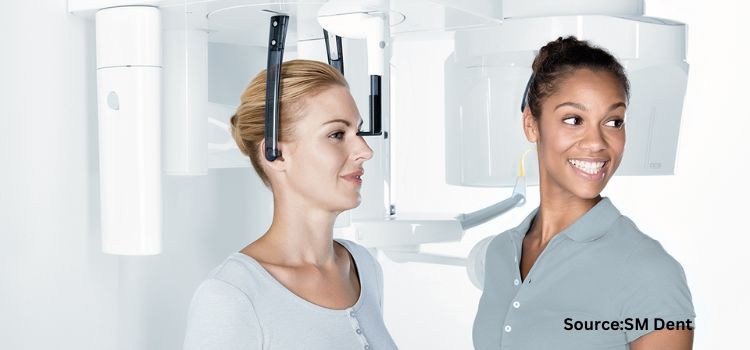
Teleradiology Market by Modality (X-Ray, Computed Tomography (CT) Scan, Magnetic Resonance Imaging (MRI), Ultrasound, Nuclear Imaging and Others), by Technology (Hardware, Software, and Telecom & Networking), by Specialty (Cardiology, Neurology, Musculoskeletal, Gastroenterology, Oncology and Others), by Application (Tele Diagnosis, Teleconsultation, and Tele Monitoring), and Others - Global Opportunity Analysis and Industry Forecast, 2023 – 2030
US Tariff Impact on Teleradiology Market
Trump Tariffs Are Reshaping Global Business
Market Definition
The global Teleradiology Market size was valued at USD 5.54 billion in 2022 and is predicted to reach USD 19.15 billion by 2030 with a CAGR of 16.7% from 2023-2030. Teleradiology is a branch of telemedicine that is defined as the practice of transmitting radiological images, such as X-rays, CT scans, and MRIs, from one location to another in order to facilitate the sharing of research among radiologists, physicians, and patients. This becomes crucial when the expertise of a sub-specialist, such as an MRI radiologist, neuroradiologist, pediatric radiologist, or musculoskeletal radiologist, is required to provide coverage for emergency radiology services during their off-hours.
Teleradiology makes it possible for qualified specialists to be accessible around the clock. It utilizes the internet and other standard network technologies, such as telephone lines or local area networks (LANs), to connect users. Specialized software is employed to transmit these radiological images, and advanced graphics processing enables radiologists to effectively analyze the data.
Market Dynamics and Trends
Increasing demand for teleradiology services across the globe owing to the high prevalence of chronic diseases such as cardiovascular diseases (CVDs), cancer and orthopedic injuries that requires radiology procedures for its diagnosis is driving the growth of the market. For instance, in 2022, according to World health organization (WHO), around 17 million people died from cardiovascular diseases (CVDs) across the world.
Also, increase in government expenditure on healthcare IT sector to digitalize patient data as it can increase efficiency and reduce errors is further driving the growth of the market. For instance, in November 2020, Department of Health and Humans Services (HHS) of United States has published a federal health IT Strategic Plan to improve the delivery and experience of patient care in the country.
However, low availability of required network facilities for teleradiology in emerging countries and shortage of skilled radiologists restrain the growth of the market. On the contrary technological advancements such as cloud computing, additive manufacturing and artificial intelligence (AI) in teleradiology is expected to create ample growth opportunities for the market in the coming years.
Market Segmentations and Scope of the Study
The teleradiology market report is segmented on the basis of modality, technology, specialty, application, end user and geography. On the basis of modality, the market is divided into x-ray, computed tomography (CT) scan, magnetic resonance imaging (MRI), ultrasound, nuclear imaging, and others. On the basis of technology, the market is classified into hardware, software and telecom & networking. The software market is further sub-segmented into picture archiving and communication system (PACS) and radiology information system (RIS). The Telecom & networking market is further sub-segmented into web-based teleradiology solutions and cloud-based teleradiology solutions.
On the basis of specialty, the market is categorized into cardiology, neurology, musculoskeletal, gastroenterology, oncology and others. Based on application, the market is divided into tele diagnosis, teleconsultation, and tele monitoring. On the basis of end user, the market is divided into hospitals & clinics, diagnostic centers and others. Geographic breakdown and analysis of each of the aforesaid segments includes regions comprising of North America, Europe, Asia-Pacific, and RoW.
Geographical Analysis
North America holds the major share of teleradiology market and is expected to continue its dominance during the forecast period. This is attributed to factors such as well-established health care infrastructure in the region along with high health care expenditure by government that increases the adaption of advanced teleradiology equipment by public health care providers in the region. For instance, in 2021, United States had spent 4.2 trillion US dollar in health sector, which is the highest in healthcare spending among the developed nations of the world.
Moreover, presence of major key players such as GE Healthcare, Mednax and Cerner Corporation boosts the market growth in this region. For instance, in August 2021, GE Healthcare launched next-generation cloud-based picture archive and communication system (PACS) called Edison True PACS. This cloud-based system will enhance reading speed, reduce errors and improve diagnostic precision & efficiency by integrating artificial intelligence (AI).
On the other hand, Asia pacific is expected to show a steady rise in the teleradiology market due to the presence of huge geriatric population that are suffering from chronic disorders such as kidney failure and heart attacks that increases the adaption of teleradiology in this region. According to the American journal of kidney diseases
Also, increase in the number of patients suffering from Osteoarthritis that requires radiology for diagnosis and surgical intervention is further driving the teleradiology market growth in this region. For instance, as of 2019, according to the national library of medicine, total number of people suffering from osteoarthritis in India is around 62 million.
Competitive Landscape
The teleradiology industry comprises of various market players such as Koninklijke Philips N.V., Agfa Healthcare, GE Healthcare, Medica Group Plc., Everlight Radiology, Radiology Partners, Cerner Corporation, Siemens Healthineers, Teleradiology Solutions and Fujifilm Holdings Corporation.
These market players launching numerous products across various regions to maintain their dominance in the teleradiology market. For instance, in May 2023, Philips launched the Philips CT 3500, an AI-powered CT scanner designed to accelerate routine radiology and high-volume screening programs. The CT 3500 is a high-throughput CT system that automates time-consuming steps of radiographers and allowing them to spend more time focusing on the patient. The launch of the Philips CT 3500, will push the global market forward by streamlining image analysis, enhancing diagnostic accuracy, and scaling operations.
Moreover, in January 2021, Medica Group Plc announced a partnership with Sectra AB. Under this partnership program Sepctra will provide a new Picture Archive and Communication System (PACS) to replace Medicas existing PACS. It is expected to help hospitals with a wide range of emergency imaging reports and elective reports using Medicas NightHawk system.
Furthermore, in December 2020 – Radiology Partners (RP) acquired the radiology division of MEDNAX, Inc. called MEDNAX Radiology Solutions for 885 million US dollar. This acquisition will help Radiology Partners to become the largest provider for comprehensive radiology and teleradiology services in the United States.
Key Benefits
-
The report provides quantitative analysis and estimations of the teleradiology market from 2023 to 2030, which assists in identifying the prevailing market opportunities.
-
The study comprises a deep dive analysis of the teleradiology market including the current and future trends to depict prevalent investment pockets in the market.
-
Information related to key drivers, restraints, and opportunities and their impact on the global market is provided in the report.
-
Competitive analysis of the players, along with their market share is provided in the report.
-
SWOT analysis and Porters Five Forces model is elaborated in the study.
-
Value chain analysis in the market study provides a clear picture of roles of stakeholders.
Teleradiology Market Key Segments
By Modality
-
X-Ray
-
Computed Tomography (CT) Scan
-
Magnetic Resonance Imaging (MRI)
-
Ultrasound
-
Nuclear Imaging
-
Others
By Technology
-
Hardware
-
Software
-
Picture Archiving and Communication System (PACS)
-
Radiology Information System (RIS)
-
-
Telecom & Networking
-
Web-Based Teleradiology Solutions
-
Cloud-Based Teleradiology Solutions
-
By Specialty
-
Cardiology
-
Neurology
-
Musculoskeletal
-
Gastroenterology
-
Oncology
-
Others
By Application
-
Tele diagnosis
-
Tele consultation
-
Tele monitoring
By End User
-
Hospitals & Clinics
-
Diagnostic Centers
-
Others
By Region
-
North America
-
US
-
Canada
-
Mexico
-
-
Europe
-
UK
-
Germany
-
France
-
Spain
-
Italy
-
Netherlands
-
Denmark
-
Finland
-
Norway
-
Sweden
-
Russia
-
Rest of Europe
-
-
Asia-Pacific
-
China
-
Japan
-
India
-
Australia
-
South Korea
-
Thailand
-
Singapore
-
Rest of Asia-Pacific
-
-
RoW
-
Latin America
-
Middle East
-
Africa
-
Report Scope and Segmentation
|
Parameters |
Details |
|
Market Size in 2022 |
USD 5.54 Billion |
|
Revenue Forecast in 2030 |
USD 19.15 Billion |
|
Revenue Growth Rate |
CAGR of 16.7% from 2023 to 2030 |
|
Analysis Period |
2023–2030 |
|
Base Year Considered |
2022 |
|
Forecast Period |
2023–2030 |
|
Market Size Estimation |
Billion (USD) |
|
Growth Factors |
High prevalence of chronic diseases fuels the adoption of teleradiology solutions.
Growing government expenditure on healthcare IT sector to digitalize patient data drives market growth. |
|
Countries Covered |
28 |
|
Companies Profiled |
10 |
|
Market Share |
Available for 10 companies |
|
Customization Scope |
Free customization (equivalent up to 80 working hours of analysts) after purchase. Addition or alteration to country, regional, and segment scope. |
|
Pricing and Purchase Options |
Avail customized purchase options to meet your exact research needs. |
KEY PLAYERS
-
Koninklijke Philips N.V.
-
Agfa Healthcare
-
GE Healthcare
-
Medica Group Plc.
-
Everlight Radiology
-
Radiology Partners
-
Cerner Corporation
-
Siemens Healthineers
-
Teleradiology Solutions
-
Fujifilm Holdings Corporation

















 Speak to Our Analyst
Speak to Our Analyst





















